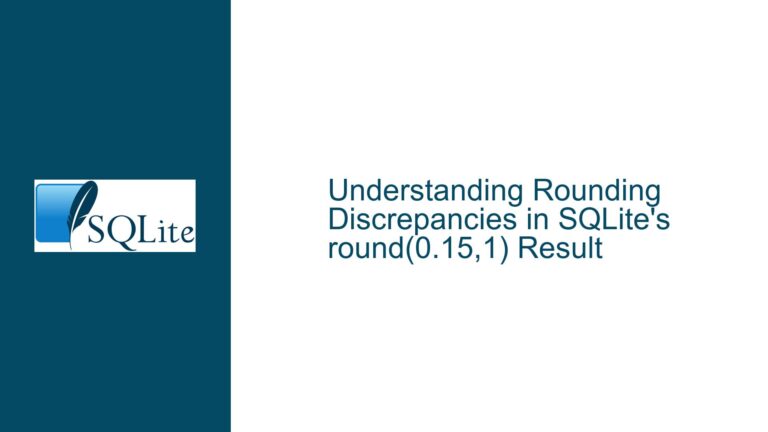and Resolving SQLite HAVING Clause Misuse in Aggregate Queries
SQLite Query Returns No Rows Due to HAVING Clause Misuse
When working with SQLite, a common pitfall that developers encounter is the misuse of the HAVING clause in aggregate queries. This issue often manifests when the HAVING clause is used to filter results based on a non-numeric expression, leading to unexpected results or no rows being returned. The core of the problem lies in the misunderstanding of how SQLite evaluates the HAVING clause and the type of expressions it can handle.
In the provided scenario, the query aims to select rows from a log table where the date (dt) is greater than a specific value, grouped by dt and time_in, and filtered by the maximum time_out. The initial query fails to return any rows because the HAVING clause uses max(time_out), which evaluates to a string that cannot be directly converted to a numeric boolean value. This results in the HAVING clause effectively filtering out all rows.
Non-Numeric HAVING Clause Expression Leading to False Evaluation
The root cause of the issue is the evaluation of the HAVING clause expression. In SQLite, the HAVING clause is designed to filter groups based on a condition that evaluates to a numeric boolean value. When the expression in the HAVING clause is non-numeric, SQLite attempts to cast it to a numeric value. If this cast results in a zero or NULL, the condition is considered false, and the group is excluded from the results.
In the case of the query in question, max(time_out) evaluates to a string representing a time (e.g., ’00:24′). When SQLite attempts to cast this string to a numeric value, it results in zero, which is interpreted as false. Consequently, the HAVING clause filters out all groups, leading to an empty result set.
This behavior is consistent with SQLite’s type affinity rules, where strings that do not represent valid numeric values are cast to zero. This can be particularly confusing when dealing with time or date strings, as they are often stored as text and may not be directly comparable or convertible to numeric values in the way one might expect.
Correcting HAVING Clause Usage and Ensuring Accurate Group Filtering
To resolve this issue, it is essential to understand the correct usage of the HAVING clause and how to structure queries to achieve the desired results. The following steps outline the process of troubleshooting and fixing the query:
Step 1: Understanding the Desired Outcome
The goal of the query is to retrieve the name, dt, and time_in from the log table for the group rows that have the maximum time_out value. This requires filtering the groups based on the maximum time_out value while ensuring that the HAVING clause correctly identifies the desired rows.
Step 2: Restructuring the Query Without HAVING Clause
The initial query can be restructured to avoid the misuse of the HAVING clause by directly selecting the maximum time_out value in the SELECT statement and grouping by dt and time_in. This approach ensures that the query returns the correct rows without relying on the HAVING clause for filtering:
SELECT name, dt, time_in, MAX(time_out) AS max_time_out
FROM log
WHERE dt > '2021-03-13'
GROUP BY dt, time_in;
This query correctly groups the rows by dt and time_in and selects the maximum time_out value for each group. However, it includes the max_time_out column in the result set, which may not be desired.
Step 3: Filtering Groups Based on Maximum time_out Value
If the goal is to return only the name, dt, and time_in columns without including max_time_out, a subquery can be used to first identify the maximum time_out value for each group and then join this result back to the original table to filter the rows:
SELECT l.name, l.dt, l.time_in
FROM log l
JOIN (
SELECT dt, time_in, MAX(time_out) AS max_time_out
FROM log
WHERE dt > '2021-03-13'
GROUP BY dt, time_in
) AS max_log
ON l.dt = max_log.dt AND l.time_in = max_log.time_in AND l.time_out = max_log.max_time_out;
This query uses a subquery to first determine the maximum time_out value for each group of dt and time_in. It then joins this result back to the original log table to filter the rows that match the maximum time_out value. This approach ensures that only the desired columns are returned without including the max_time_out column in the final result set.
Step 4: Handling Edge Cases and Ensuring Consistency
It is important to consider edge cases where multiple rows may have the same dt, time_in, and time_out values. In such cases, SQLite may return any one of the matching rows, as noted in the SQLite documentation. To ensure consistency and predictability, additional criteria or ordering can be applied to the query:
SELECT l.name, l.dt, l.time_in
FROM log l
JOIN (
SELECT dt, time_in, MAX(time_out) AS max_time_out
FROM log
WHERE dt > '2021-03-13'
GROUP BY dt, time_in
) AS max_log
ON l.dt = max_log.dt AND l.time_in = max_log.time_in AND l.time_out = max_log.max_time_out
ORDER BY l.name, l.dt, l.time_in;
By adding an ORDER BY clause, the query ensures that the results are consistently ordered, which can be particularly useful when dealing with potential duplicates or when the order of results is important.
Step 5: Alternative Approaches Using Window Functions
For more complex scenarios or when working with larger datasets, window functions can be used to achieve the same result more efficiently. Window functions allow for the calculation of aggregate values without the need for subqueries or joins:
SELECT name, dt, time_in
FROM (
SELECT name, dt, time_in, time_out,
ROW_NUMBER() OVER (PARTITION BY dt, time_in ORDER BY time_out DESC) AS rn
FROM log
WHERE dt > '2021-03-13'
) AS ranked_log
WHERE rn = 1;
In this query, the ROW_NUMBER() window function is used to assign a unique rank to each row within its group of dt and time_in, ordered by time_out in descending order. The outer query then filters to include only the rows with a rank of 1, which corresponds to the rows with the maximum time_out value for each group.
Step 6: Ensuring Compatibility and Performance
When implementing these solutions, it is important to consider the compatibility and performance implications. The subquery and join approach is compatible with most SQL databases, while the window function approach may not be supported in all SQLite versions or other lightweight databases. Additionally, the performance of each approach may vary depending on the size of the dataset and the complexity of the query.
To ensure optimal performance, it is recommended to test each approach with the specific dataset and environment in which it will be used. Indexes on the dt, time_in, and time_out columns can also improve query performance by reducing the amount of data that needs to be scanned and processed.
Step 7: Best Practices for Future Queries
To avoid similar issues in the future, it is important to follow best practices when writing SQL queries:
- Understand the Data Types: Ensure that the data types of the columns being used in the query are understood and that any necessary type conversions are handled explicitly.
- Use HAVING Clause Appropriately: Only use the
HAVINGclause for filtering groups based on aggregate values that evaluate to numeric boolean expressions. - Test Queries Thoroughly: Test queries with a variety of data to ensure that they behave as expected and handle edge cases correctly.
- Consider Alternative Approaches: Explore different approaches, such as subqueries, joins, and window functions, to achieve the desired results efficiently.
- Document Queries: Document the purpose and logic of complex queries to make them easier to understand and maintain in the future.
By following these steps and best practices, developers can avoid common pitfalls when working with SQLite and ensure that their queries are both accurate and efficient.






